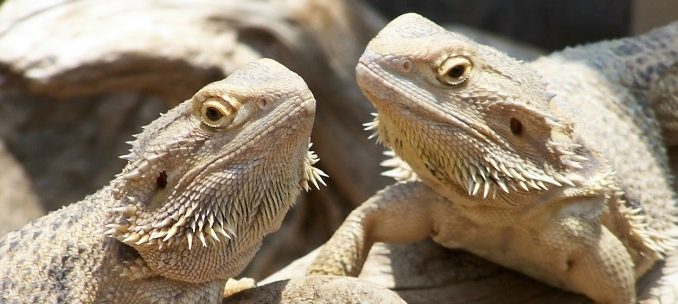
The new pet store are stars definitely bearded dragons. Interest in these fascinating creature is rising very fast, but shamefully, too many people adopting one crucially lack information on how to care properly for them. This is why we have gathered in one post all you need to know about regular bearded dragons: the environment they need, their food requirement, but also what you should never do. We have a lot to say, so let’s just go for it!
Bearded Dragon Care Sheet
These little reptiles might be quite tame, they are yet very smart and friendly. They can grow up to 24 inches (60cm) and can live up to 10 years! Are you ready for a long-lasting pet friend? If yes, here is how you can take care of him at best.
Enclosure
Opt for a wide and low tank in order to provide the maximum floor place, as they need to be “active” to stay happy and healthy. Baby bearded dragons can be kept in small 20 gallon tanks, but know that once they get to their adult size, they will need at least a 40 gallon container. Best is to go for a big size straight, so you don’t have to change during his lifetime, which could be disturbing for him.
Note also that it is not recommended to keep more than one dragon in one tank. Male are solitary, women are more sociable but still can have dominance issues, and male and female together… Well, no need for a drawing to understand what will happen.
Substrate
Many recommend sand as a substrate, but know that it can be harmful over time if your reptile ingests too much of it with its food, which is most likely if you just put the food at the bottom of the tank. Also, most substrates available at pet store are not really suitable.
At first, when they are still babies, the best solution would be to use newspaper, paper towels, outdoor carpeting or reptile carpet, and change it often to provide a healthy environment. Once they get to their adult size, then only you may consider more permanent material: ceramic or slate tiles are perfectly adequate as they are very easy to clean (you need to scoop the feces daily!). About that, never use chemicals, at most a 10% bleached solution.
Find An Exotic Pet Veterinary
When you adopt a bearded dragon, one of the first thing you need to do is to find an exotic pet vet, as dragons are sensitive to all sorts of parasites that can be deadly to them: taking a fecal sample is the cheapest way to solve this problem, which some vet accept doing without seeing the animal and charging for an appointment.
A little word of caution about salmonella, which most reptiles carry naturally: remember to always wash your hands after petting them and make sure to use different dishes and towel than the ones you use for yourself.
Furniture
Bearded dragons love:
- laying upright: make sure to use the spaces up high with furnitures that are easy to grip,
- being warm: rocks are excellent for this, as they warm up from the light,
- plants: real or artificial, reptiles seems to love plants like ponytail palms, snake plants, jade or pothos. Just make sure they are free of chemicals and prepare to replace them, as your beardie might eat them!
- hiding: hiding is definitely bearded dragons’ favourite hobby. Make sure to provide several hiding places, like logs or upside-down flower pots.
If you provide your beardie with all these stuffs, it is most likely that he will live a happy life. But remember, they grow fast and still need space to move, so don’t overcrowd the cage!
Lightning and Heating
Lightning is crucial to bearded dragons. They should be on a cycle of about 10-14 hours on in the summer and 10-12 hours on in the winter. You will need 2 types of lights.
UVB light
An UVB light is essential to reptiles as it simulate the sun, allowing your dragon to produce vitamin D3 and calcium. Without it, most reptiles get Metabolic Bone Disease (MBD). Unique reptile fluorescent bulbs – like the Reptisun 5.0 or the Reptisun 10.0. – are necessary: they need to be within 12 inches (30 cm) of the basking spot and need to be replaced every six months because the amount of UVB diminishes.
Heat lightning
You need to provide your pet with a heat lightning, like standard household bulbs, reptile basking bulbs, or standard spotlights. Bearded dragons need heat to digest their food, so it’s crucial you use a thermometer to monitor the heat daily. The optimal heat is around 40°C (105°F), a bit more for babies.
Given the size of your tank, a 100 watts bulb should be enough. If you need more, you might find 150-200 watts bulbs in improvement stores. Make sure to place the heating light above the basking spot and on the same size of the cage. The other side, where your pet won’t sleep, can be cooler (no lesser than 25°C – 75°F). At night, if the temperature doesn’t go under 18°C (65°F), your beardie shouldn’t need the heat lightning.
Some pet store will advise a new kind of light that combines UVB and heat in one bulb, but we don’t recommend it as they are quite expensive and have been known to break easily. Also we are not really sure if they are safe.
Food
Vegetables
Beardies need leafy greens daily. Make sure to wash them properly before feeding it to your pet and try to vary. Know that lettuce is not much nutritional and should not be given predominantly. Remember to remove large stems and rotten parts and rip the greens into pieces about the size of your dragons head. You can also wet the greens before feeding them in order to provide extra water to your dragon.
Other vegetables, like winter squashes, green beans, parsnips, carrots, sweet potato, etc, can be grated up and added to the salad. Indeed, dragons can not chew large chunks, and it will be hard for them to digest. You can also feed him fruits such as berries, mango, papaya or grapes, but only in small amounts.
Insects
Insects are dragons’ favourite meal, but like kids with sweets, you shouldn’t give them too much of it: 2 or 3 times a day for babies, gravid dragons or after brumation, 1 time at most for regular adults. Otherwise, your lizard could be at risk of kidney disease. Make sure that you give greens before insects to make sure your little one will eat its vegetables!
Crickets, super worms, roaches, phoenix worms, hornworms, and silkworms are all suitable, however never feed them with mealworms or pinky mice because of the risk of parasites. If you feed crickets, just give them as many as they can eat in a 5 to 10 minutes period; baby dragons can eat up to 50 crickets in a sitting!
Important things to know are:
- never leave crickets in the cage overnight: they can seriously hurt the baby lizards by munching on them as food. One solution is to feed your pet in a separate cage.
- never give babies large crickets, and in general, never give dragons anything to eat that is bigger than the space between their eyes.
- NEVER feed fireflies as they are TOXIC to bearded dragons and can cause DEATH within hours!
Water
It may come as a surprise, but we do not recommend providing a water dish for your dragon as he will either defecate in it or crickets will drown in it, which is not optimal for an healthy environment. The best way to hydrate your animal is to spray its vegetables with spring or filtered water (in order to avoid the chemicals added to tap water).
Also, most beardies seem to enjoy bath and swimming, although they can’t stand swimming for a long time. We recommend you put them in the tub on a weekly basis, always watching over them. Just make sure they can still stand easily and that you dry them well before putting them back in the cage: too much moisture or dampness could cause fungal diseases.
This is how to care for a regular bearded dragon. We’ll be back in a new post about specificities like brumation symptoms, shedding process and special care for gravid dragons. Stay connected!

Leave a Reply